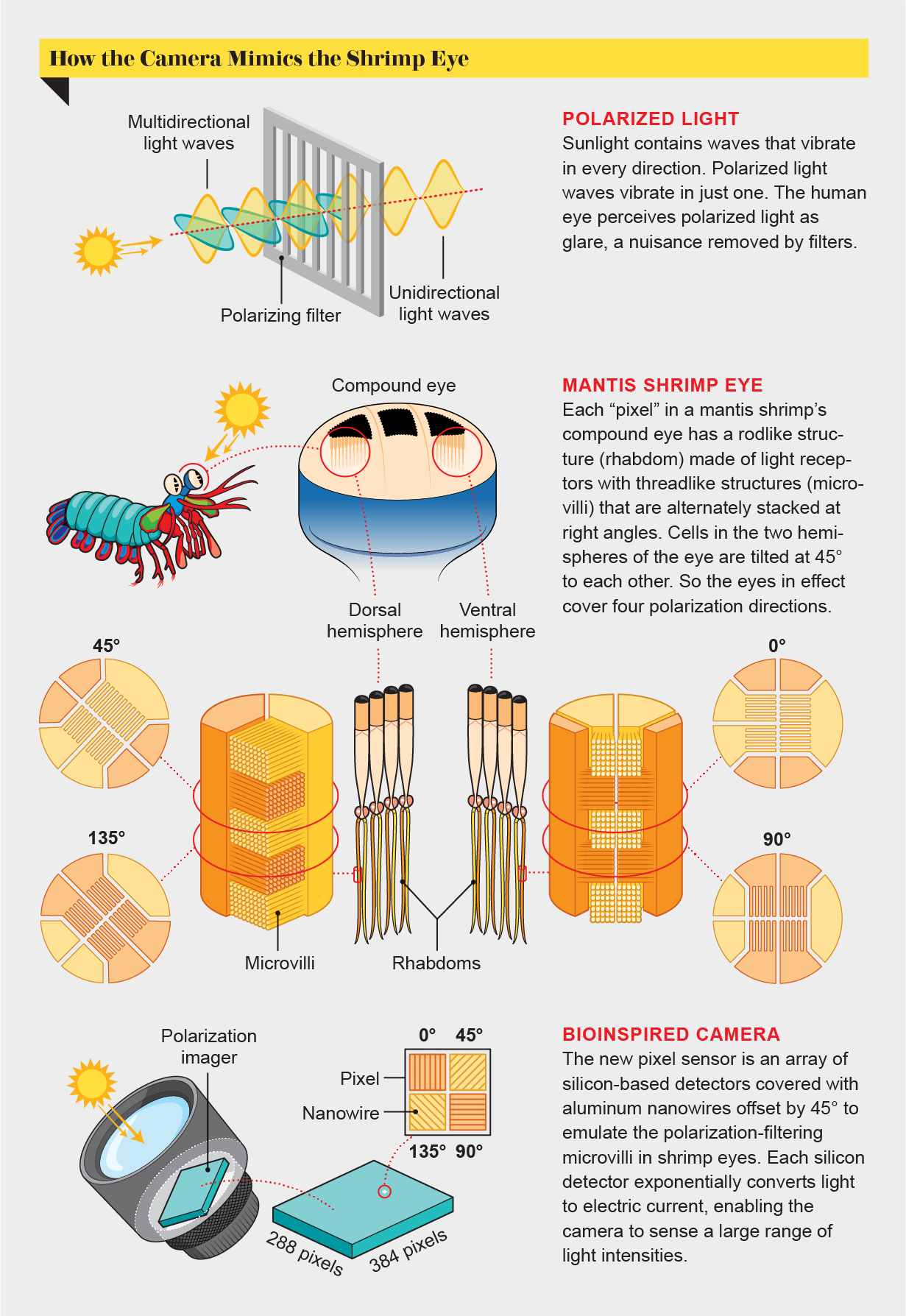I who work in the field of Computer Vision have always been curious about creatures that have different abilities from us. Computer Vision is an interdisciplinary scientific field that deals with how computers can gain meaning from digital images or videos.
While this discipline aims to give the ability of sight to a machine, it stands for not only trying to understand the creature that has the best visual ability, and how that creature senses/perceives the world but also considering the goal of “the best seeing”.
Then, here is Stomatopoda, the creature that has the best visual system in the world! (Best known as Mantis shrimp)

The eyes of Mantis shrimps, or stomatopods, are mounted on movable stalks and can move without being dependent to each other. It is thought that they have the most complex eyes and the visual systems in the animal kingdom. Some breakthrough advancements in technology such as the development of next-generation communication systems might be resulted from the eyes of mantis shrimps. The eyes of Mantis shrimps can perceive at least 100,000 colors which is ten multiple of the humans’.
Let's Get to Know the Stomatopodas Better
Mantis shrimps, or Stomatopods, are carnivorous marine crustaceans of the order Stomatopoda, which branched out from other members of the Malacostraca class about 340 million years ago.
Each living thing on the earth has a different eyesight. In our eyes, there are receptors that allow us to see colors. Dogs have two types of photoreceptors (green and blue), while humans have three types (red, green, and blue). Moreover, birds have four types of photoreceptors (red, green, blue and UV). How many photoreceptors do you think Mantis shrimps have?

Mantis shrimps have 16 types of receptors. Twelve of these receptors are responsible for color perception and the other four are responsible for color filtering. Neurologist Daniel Osorio from the University of Sussex likens this situation to wearing tinted glasses and says that: 'These filters block some frequencies of light while allowing others to pass through. This can be compared to wearing glasses with yellow lenses to reduce the blue light and increase clarity in cloudy weather.'
Mantis shrimps actively fluoresce during their mating rituals, and the wavelength of this fluorescence matches the wavelengths detected by the eye pigments. Females are fertile only during certain phases of the tidal cycle. Therefore, the ability to sense the phase of the moon can help prevent wasted mating efforts. Also, this situation can give information about the extent of the tide to the shrimps, which is very important for species that live in shallow water. Thanks to their superior vision, they can calculate the depth and the distance between an object and themselves. Thus, it even becomes impossible for us to imagine what the Mantis shrimps perceive.
The eyes of mantis shrimps, which were set on stalks, can be turned as fast as several hundred degrees per second. As a result, they have a very wide field of view. Mantis shrimps can use all three visual regions in their eyes simultaneously. It can have a tri-central (trinocular) vision, taking the binocular vision seen in many animal species, including humans, one step further.
The light range that mantis shrimps can see is also much wider than that of humans. They can easily see even the lights in the infrared and ultraviolet area for humans. Humans can see from the 400-nanometer wavelength of the blue light to the 700-nanometer wavelength of the red light. Furthermore, Mantis shrimps can range from 250-300 nanometers (which we don't have colors to define, we define ultraviolet) to 800-900 nanometers (similarly, we can only define this as infrared)

Inspired Engineers Aim to Develop Advanced Systems
Mantis shrimps, thanks to their eyes which have a feature that is not found in any other creature in the animal kingdom, can perceive light known as a circular polarizing filter (CPL). CPL is formed by the 360-degree rotation of electromagnetic waves around the axis of a light beam. This ability of the Mantis shrimps, who are the only creature in the world with the perception of CPL, was discovered in 2008. This feature of the shrimp was first announced in March of the same year by the Current Biology journal. Inspired by this, engineers aim to develop advanced technology communication systems in which light can be used much more effectively thanks to the CPL sensing ability of Mantis shrimps.
The engineers intend to improve the image quality by obtaining a much stronger resolution by the ability of the free rotation movement of the light, as in CPL.
Researchers suspect that wider diversity of photoreceptors in the eyes of Mantis shrimps allows visual information to be preprocessed by the eyes rather than the brain. Otherwise, their brains would have to be bigger to deal with the complex task of color perception. While their eyes are so complex and have not yet been fully understood, the principle of the system seems simple. It has a similar set of sensitivities to the human visual system; but however, it works in the opposite way. In human brains, the inferior temporal cortex has a large number of color-specific neurons that process visual stimuli from the eyes to create colorful experiences. The mantis shrimp instead uses different types of photoreceptors in its eyes to perform the same function as human brain neurons, resulting in a more efficient system for an animal that requires fast color identification. Humans have fewer types of photoreceptors, and even there are more color-tuned neurons, Mantis shrimps seem to have fewer color neurons and more photoreceptor classes.
According to a paper from the University of Queensland, the compound eyes of Mantis shrimp can detect cancer and the activity of neurons because they are sensitive enough to differentiate the polarized lights that are reflected from a cancerous tissue or a healthy tissue. The study claims that this ability could be replicated via a camera through the use of aluminum nanowires to replicate polarization-filtering microvilli on photodiodes.

This article is compiled from the following sources. I would like to thank Zehra Nur Günindi and Muhammed Emin Arayıcı for their valuable contributions and translation support in the creation of the article.
►►Sources:
- core.ac.uk/download/pdf/43365607.pdf
- avaschroedl.com/vision-in-mantis-shrimp
- scientificamerican.com/article/camera-mimic..
- aeon.co/videos/how-the-mantis-shrimps-six-p..
- npr.org/sections/health-shots/2016/11/15/50..
- science.org.au/curious/earth-environment/al..
- stringfixer.com/en/Stomatopod
- en.wikipedia.org/wiki/Mantis_shrimp
- bilimup.com/evrenin-en-guclu-bokscusu-manti..
- evrimagaci.org/dunyanin-en-guclu-yumrugu-ma..
- evrimagaci.org/gorme-yetimiz-anlamsiz-kilan..
- en.peopleperproject.com/posts/5169-mantis-s..
- kusursuzyaratilis.com/mukemmel-gozlere-sahi..
- ieeexplore.ieee.org/stamp/stamp.jsp?tp=&..
- ieeexplore.ieee.org/document/6880796
- hayretedecek.com/dunyanin-en-guclu-canlisi-..
- ntboxmag.com/2018/10/12/mantis-karidesinde-..
- hurriyet.com.tr/dunya/umut-bu-iki-goze-bagl..
- youtube.com/watch?v=eGuZifKr0h4&ab_chan..
- youtube.com/watch?v=t2FTavvZt_c
- youtube.com/watch?v=ujrsE3ljcv4


